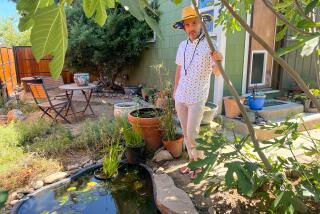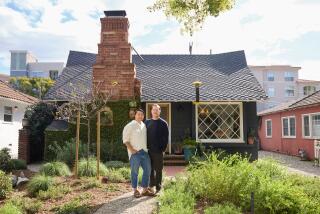Harmless Deposits That Build Up on Clay Pots Are Removable
Question: My clay pots tend to turn white at the base or the clay starts to chip off. I wash them and I was told to put gravel in the bottom for drainage but I still have this problem. Can you help me?
--T.T., Monterey Park
Answer: Plants prefer growing in terra cotta pots because the clay is porous and breathes. This wick-like action is beneficial to plants but can make inexpensive pots erode and flake, generally because the clay wasn’t fired in a kiln, or it is a soft kind, according to Gloria Lopez at Pottery Manufacturing & Distributing in Gardena.
The white deposits are calcium and other minerals found in our water or in fertilizers. The wicking action of the clay causes them to accumulate on the outside, where they will not harm pot or plant.
To find quality pots that will last, Lopez says, give them a sharp tap. Those that have been high-fired will ring like a bell. Short-lived, low-fired pots have a dull ring (if they don’t ring but “thump,” the pot is probably cracked).
Lopez says that American and Italian pots are high-fired and will last a very long time but that most other imports--whether from Africa or China--should be protected with special pottery sealers available at nurseries. Be aware that these sealers will give pots a sheen. Do not use Thompson’s Waterseal or concrete sealers, as these are toxic to plants.
Many rough, inexpensive, low-fired Mexican pots have asphalt painted inside--an attempt to prolong their life--but once tar has been painted on, the pots can no longer breathe, so you lose the benefits of clay.
On sound pots that are not already eroding, you can get rid of mineral deposits if you find them unsightly. Remove as much as you can with a wire brush and then apply linseed oil, which will make the powdery deposits invisible, or try to dissolve them with vinegar and water, or with a 10% solution of hydrochloric acid. Rinse well afterward.
The linseed oil makes the pot look shiny and new, but many gardeners prefer the opposite effect, encouraging white deposits, green algae and other things that make a terra cotta pot look old. Some actually paint on lime to hasten the “whitening.”
Putting gravel in the bottoms of pots to improve drainage is a garden myth that refuses to die. Gravel does not help drainage but simply takes up valuable root space. All that’s required is some kind of screen to cover the drainage hole, to keep soil in, and pests like slugs out. I use window screening, which lasts forever. Some gardeners like to use cut up coffee filters, though I don’t know how long they last. Either is better than the frequently recommended piece of broken flower pot, which allows soil to wash out and bugs to crawl in.
*
Q: Last week I planted three bougainvillea and several salvias. Today the leaves on them are drooping, yet I watered with B-12 when I first planted and the soil still seems wet. What’s wrong?
--N.O., Woodland Hills
A: Another myth that dies hard is the efficacy of vitamin B-12. Decades ago, it was shown to have no effect on the establishment of plants, though it does force gardeners to thoroughly water new plantings, which is a good thing. Your plants have simply dried out.
Even though the soil around the new plants may be wet, the potting mix in the root ball is dry. Push your finger into the root ball to check and let that be your guide for when to water. This is a common problem at this time of year when natural soils may take weeks to dry, but potting soils can dry in days (especially during a Santa Ana). Other than simply checking the root ball, here are steps that make sure new plantings get off to a good start:
* Several days in advance, begin by watering the ground where you are to plant so it is moist and not bone-dry at planting time.
* The day before planting, thoroughly water plants while they are still in their containers, so plants are well hydrated.
* Mound up little watering basins around the plants to help funnel water to their root balls. However, break these down during rainy weather so plants don’t drown.
* To see when new plants need watering, always check the plant’s root ball, not the surrounding soil.
Although over-watering may be the No. 1 killer of plants in California, it is almost impossible to over-water brand-new plantings that are only days or weeks old (as long as your soil has decent drainage and planting holes don’t hold water like a bathtub). Remember that all the roots are confined in that tiny, fast-draining root ball and it will take several weeks or more for them to grow out into the surrounding soil.
*
Q: I would like your opinion of the safety of using old railroad ties for a raised vegetable garden.
--F.Y., Manhattan Beach
A:. Organic Gardening Magazine is adamant about not using railroad ties or pressure-treated lumber around edibles and have done a number of articles on the subject. The editors point out that some studies show that toxic substances leach from these woods.
For that reason, I would never use railroad ties near any edible. My own raised beds are made of redwood 2-by-8s. They are six years old and only now are beginning to rot where they are buried underground.
An even better choice would be one of the new artificial timbers made from recycled plastic. Or simply line up concrete blocks to make a bed, though you might want to locate old, used blocks that no longer leach lime, which makes soils alkaline.
*
Questions should be sent to Garden Q&A; in care of Southern California Living, Los Angeles Times, 202 W. 1st St., Los Angeles, CA 90012. Please include your address and telephone number. Questions cannot be answered individually.






